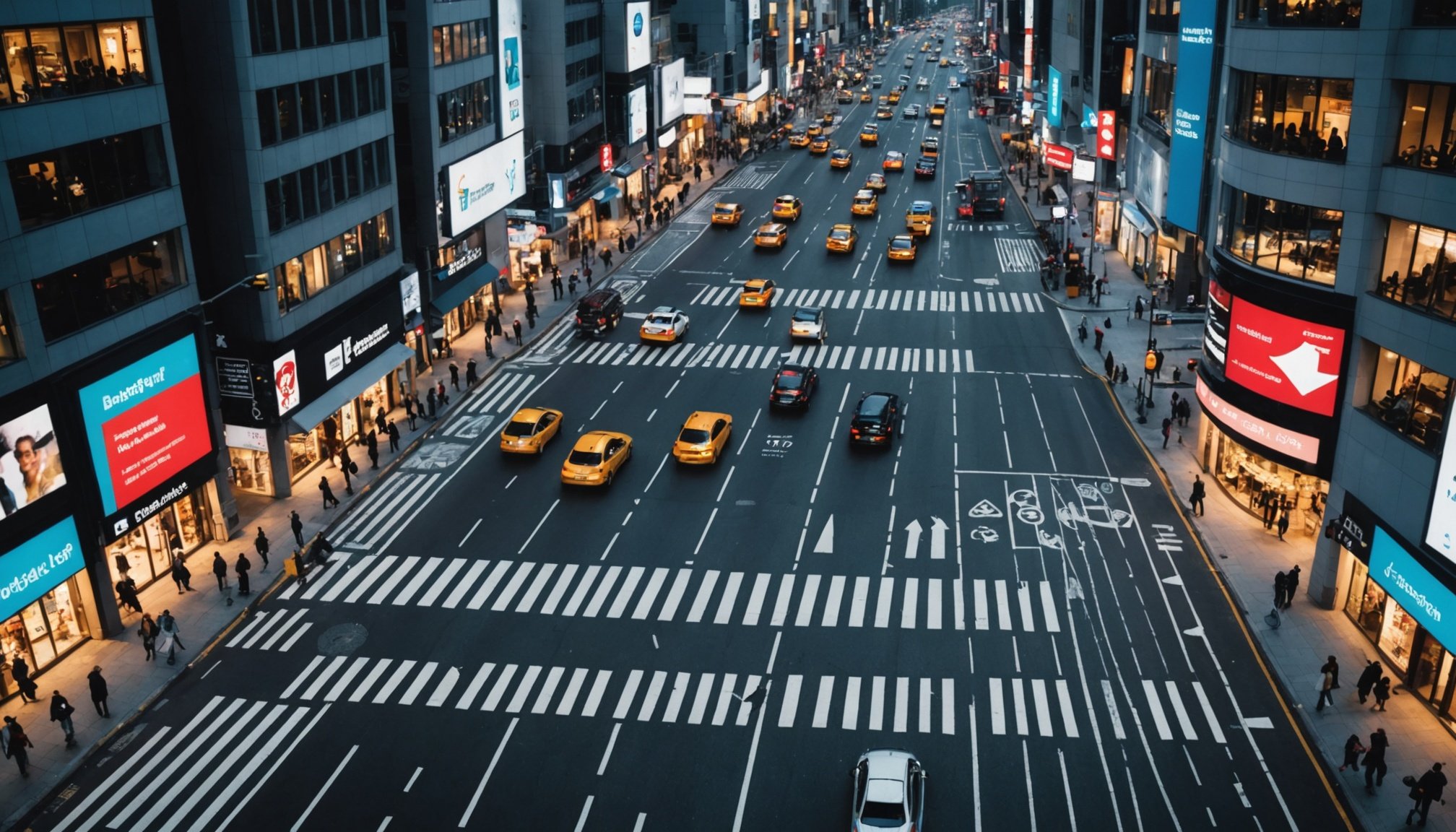Understanding Real-Time Pedestrian Traffic Data
Real-time pedestrian data is crucial in urban planning, as it provides insights into traffic patterns and population dynamics. This data allows urban planners to make informed decisions that can enhance city infrastructure.
With advancements in technology and the Internet of Things (IoT), urban data collection and traffic analysis have become more sophisticated. Devices like sensors and cameras enable the collection of real-time data, which is processed to reveal footfall, pedestrian routes, and peak movement times. This technology not only speeds up data gathering but also improves its accuracy and reliability.
This might interest you : Transforming UK Real Estate: The Game-Changing Role of Augmented Reality in Property Tours
Understanding urban mobility patterns through pedestrian traffic data is essential for designing efficient transport systems. For instance, real-time data can highlight areas of high pedestrian traffic, informing where pedestrian paths need to be widened or where new crossings might be necessary. Additionally, analysing this data helps pinpoint underused routes, aiding in better resource distributions.
The integration of IoT in these processes is not only transformative but also establishes a data-rich environment for urban planners. Utilising this information alongside predictive analytics, cities can evolve into smarter, more interconnected environments that reflect the dynamic needs of their residents.
This might interest you : Mastering Retail Triumph: Leveraging AI to Predict Consumer Trends
Benefits of Utilizing Pedestrian Traffic Data in Urban Planning
Leveraging pedestrian traffic data offers significant urban benefits, bolstering public safety and enhancing accessibility. By meticulously analysing foot traffic patterns, city planners can design safer pedestrian environments, optimising crosswalks and lighting. This adaptation ensures that public spaces are navigable and welcoming to all, reducing the likelihood of accidents.
Additionally, data-driven decisions are pivotal in promoting sustainable urban development. Through the identification of congestion patterns, planners can devise strategies to alleviate traffic pressures. This involves creating pedestrian-friendly zones and integrating eco-friendly transport options, which contribute to the sustainable growth of cities.
Furthermore, traffic data empowers urban areas to improve resource allocation. Understanding peak pedestrian times aids in infrastructure responsiveness, enabling adaptive measures such as dynamic lighting systems. Consequently, cities can better manage resources, ensuring they’re deployed effectively where needed most.
Ultimately, by making informed, data-backed decisions, cities evolve into more efficient, sustainable environments. The focus shifts towards minimizing congestion and enhancing quality of life for residents, reaping substantial long-term benefits from these innovative approaches in urban planning.
Case Studies: Successful Implementations
Examining urban case studies reveals how pedestrian traffic data can transform city landscapes. Various cities worldwide have embraced smart city initiatives to enhance public services.
City X: Leveraging Data for Public Transport Enhancements
City X integrated pedestrian data with existing transit systems, successfully reducing commuter times. By mapping pedestrian trends, the city identified and expanded bus routes, aligning them with peak foot traffic zones. This not only improved transport efficiency but also bolstered public satisfaction with the transit system.
City Y: Increasing Retail Foot Traffic with Traffic Data
Pedestrian insights have proven invaluable for City Y as it revitalised its retail districts. Using real-time traffic analysis, planners identified underutilised retail areas, launching targeted campaigns to reroute shoppers. These efforts stimulated economic growth, showcasing the potential of data in urban planning.
City Z: Data-Driven Disaster Response Planning
Innovatively, City Z employed pedestrian data for disaster response planning. By analysing movement patterns, emergency response teams have improved evacuation route planning, significantly shortening response times in crises. This proactive approach highlights the importance of data in safeguarding urban populations.
These best practices demonstrate how data-driven urban strategies can enhance both functionality and safety, fostering more resilient communities.
Challenges and Considerations in Data Application
Navigating the landscape of data challenges requires careful attention, especially when it comes to privacy concerns and ethical considerations. Gathering real-time pedestrian data raises questions about personal data security. It’s crucial for urban planners to employ strategies that anonymise information, ensuring individuals’ privacy is protected while still harnessing valuable insights.
Implementing real-time data systems presents numerous technical and financial obstacles. Urban areas need to invest in infrastructure equipped with sophisticated sensors and cameras, which can strain budgets. Additionally, technical expertise is essential to manage these systems, analysing and interpreting the data proficiently to inform urban planning.
Balancing data accessibility with accuracy and reliability is central to effective data application. While it’s essential to collect comprehensive data to fully understand pedestrian dynamics, ensuring its precision is equally crucial. Urban planners must ensure the data reflects real-world scenarios to support well-informed decisions.
These hurdles require multifaceted approaches for successful data incorporation into urban environments. Cities can benefit from public-private partnerships that share resources and expertise, helping overcome implementation barriers. Collaborative efforts can help mitigate these challenges, fostering cities that responsibly integrate data while maintaining public trust.
Future Trends in Urban Planning with Real-Time Data
Real-time data is revolutionising urban planning, providing a lens into emerging technologies and trends. As cities evolve, smart city concepts are increasingly anchored in predictive analytics. Predictive analytics utilises historical and current data to foresee future scenarios, enabling proactive urban development. This technology enhances planners’ capabilities by anticipating changes in pedestrian behaviour and traffic patterns, thus facilitating preemptive measures that maintain efficiency and safety.
Moreover, the integration of the Internet of Things (IoT) continues to be pivotal. IoT enables interconnectedness among devices, contributing significantly to real-time data collection. This advancement supports more sophisticated analyses of pedestrian movement, helping planners to devise data-informed solutions that better meet urban demands.
The evolving role of urban planners is marked by a shift towards a data-centric approach. Planners are now tasked with not only interpreting but also strategically deploying these insights to foster sustainable development. As data availability increases, planners must adapt by harnessing new technologies to address both existing and future urban challenges. Embracing these trends can lead to more resilient, adaptive cities capable of responding to the complex dynamics of modern urban life.
Recommendations for Urban Planners and Stakeholders
Integrating pedestrian traffic data effectively into urban planning involves a few key strategies. Urban planners should focus on fostering collaboration among stakeholders, including government bodies, technology developers, and the community. This holistic approach ensures diverse perspectives are incorporated, enriching planning processes.
Stakeholder engagement is vital in developing action plans that align with community needs. Encouraging open forums and workshops can facilitate conversations that lead to more inclusive strategies. Collaboration not only promotes understanding but also helps to allocate resources appropriately.
It’s crucial to establish best practices for ongoing evaluation of urban data initiatives. Regular assessments allow for timely adjustments, ensuring that planning continues to align with actual traffic patterns. Adopting flexible, data-driven frameworks can aid in these evaluations, making planning more responsive and adaptive.
Urban planners need to prioritize the integration of data systems with existing structures. This involves upgrading infrastructure to support real-time data analytics and investing in user-friendly platforms for easy data interpretation. By aligning data insights with urban policies, planners can develop sustainable action plans that enhance urban environments.
Effective use of these strategies ensures cities remain dynamic and resilient, continually evolving with the needs of their residents.



